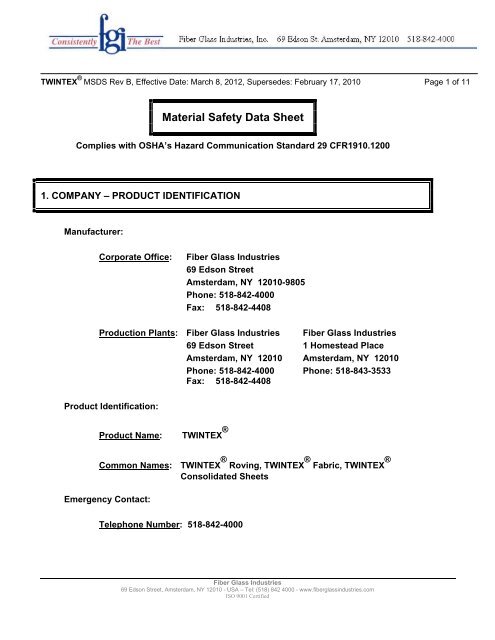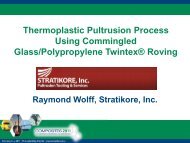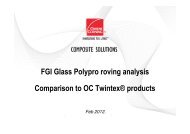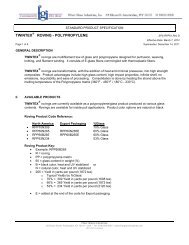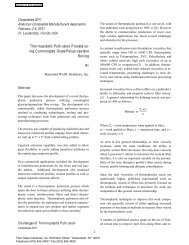Twintex® MSDS - Fiber Glass Industries, Inc
Twintex® MSDS - Fiber Glass Industries, Inc
Twintex® MSDS - Fiber Glass Industries, Inc
You also want an ePaper? Increase the reach of your titles
YUMPU automatically turns print PDFs into web optimized ePapers that Google loves.
TWINTEX ® <strong>MSDS</strong> Rev B, Effective Date: March 8, 2012, Supersedes: February 17, 2010 Page 1 of 11<br />
Material Safety Data Sheet<br />
Complies with OSHA’s Hazard Communication Standard 29 CFR1910.1200<br />
1. COMPANY – PRODUCT IDENTIFICATION<br />
Manufacturer:<br />
Corporate Office: <strong>Fiber</strong> <strong>Glass</strong> <strong>Industries</strong><br />
69 Edson Street<br />
Amsterdam, NY 12010-9805<br />
Phone: 518-842-4000<br />
Fax: 518-842-4408<br />
Production Plants: <strong>Fiber</strong> <strong>Glass</strong> <strong>Industries</strong> <strong>Fiber</strong> <strong>Glass</strong> <strong>Industries</strong><br />
69 Edson Street 1 Homestead Place<br />
Amsterdam, NY 12010 Amsterdam, NY 12010<br />
Phone: 518-842-4000 Phone: 518-843-3533<br />
Fax: 518-842-4408<br />
Product Identification:<br />
Product Name: TWINTEX ®<br />
Common Names: TWINTEX ® Roving, TWINTEX ® Fabric, TWINTEX ®<br />
Consolidated Sheets<br />
Emergency Contact:<br />
Telephone Number: 518-842-4000<br />
<strong>Fiber</strong> <strong>Glass</strong> <strong>Industries</strong><br />
69 Edson Street, Amsterdam, NY 12010 - USA – Tel: (518) 842 4000 - www.fiberglassindustries.com<br />
ISO 9001 Certified
TWINTEX ® <strong>MSDS</strong> Rev B, Effective Date: March 8, 2012, Supersedes: February 17, 2010 Page 2 of 11<br />
2. HAZARDS COMMUNICATION<br />
TWINTEX ® , a commingled product based on reinforcement glass fibers and thermoplastic filaments,<br />
are available in the form of: ROVINGS, FABRICS, or CONSOLIDATED SHEETS<br />
This Material Safety Data Sheet is valid for all these products.<br />
TWINTEX ® <strong>Glass</strong> fibers can be considered as ARTICLES, as fibers, woven fabrics and sheets that<br />
are defined as articles in the manual of decisions for implementation by TSCA (Toxic Substances<br />
Control Act) or EPA 40 CFR 710.2 and DSL in Canada. These articles are mixtures of E GLASS in<br />
the form of continuous strands, a SIZE, and a THERMOPLASTIC POLYPROPYLENE RESIN (PP) in<br />
the form of commingled filaments. The CAS (Chemical Abstract Service) reference number for glass<br />
fibers is 65997-17-3 (corresponding to the oxides used for its production).<br />
The E GLASS in TWINTEX ® is a glass with a very low alkaline content. Its composition (expressed in<br />
oxides) is within the following percentages:<br />
SiO2 52-62%<br />
Alkaline Oxides (Na2O, K2O) < 2%<br />
Alkaline earth oxides (CaO, MgO....) 16-30%<br />
B2O3 0-10%<br />
Al2O3 11-16%<br />
TiO2 0- 3%<br />
Fe2O3 0- 1%<br />
F2 0- 2%<br />
Note: The E GLASS portion of TWINTEX ® is typically 60% of the product by weight but product<br />
offerings may range between 50% to 85% glass.<br />
SIZE is a mixture of chemicals applied to the glass strands typically applied between 0.8% and 1.5%.<br />
Most of this mixture is made up of non reactive high molecular weight polymers and are generally<br />
exempt from registration on TSCA. In some cases, sizes are prepared from polymers with reactive<br />
ingredients or containing reactive monomers included on TSCA. Most of the reactive ingredients are<br />
polymerized during the manufacturing process. However a very small reactivity may remain which<br />
justifies the precautionary measures listed in Section 8 below. A second type of ingredient present in<br />
almost all sizes is a member of the organo-silane family. These products account for less than 0.05%<br />
of the final weight of sized E glass. These products are included in lists of products requiring<br />
'hazardous product' labeling in a pure state, as toxic if swallowed or inhaled, harmful in contact with<br />
the skin, and an irritant for the eyes. The manufacturer considers this risk as negligible as, although<br />
<strong>Fiber</strong> <strong>Glass</strong> <strong>Industries</strong><br />
69 Edson Street, Amsterdam, NY 12010 - USA – Tel: (518) 842 4000 - www.fiberglassindustries.com<br />
ISO 9001 Certified
TWINTEX ® <strong>MSDS</strong> Rev B, Effective Date: March 8, 2012, Supersedes: February 17, 2010 Page 3 of 11<br />
listed as dangerous products, the concentration is extremely low and they are polymerized during the<br />
production of E glass fibers. Other products can be used in sizes. Usually the content is extremely<br />
low (under<br />
0.1% of total weight) and as a general rule such products are not on the dangerous product lists or, as<br />
they have reacted, any possible risk has been reduced.<br />
The THERMOPLASTIC POLYMERS used for commingling with the glass filaments to produce<br />
TWINTEX ® are high molecular weight polymers. The thermoplastic component is typically present at<br />
40% volume by weight but product offerings may range between15% to 50% thermoplastic. The<br />
majority of polymers are not listed as dangerous products.<br />
The CAS reference numbers of the base polymer Polypropylene (PP) is: 9003-07-0<br />
The thermoplastic portion main contain, as is general for all polymers, some ADDITIVES intended to<br />
improve processing, durability, or the resistance to external agents. They are introduced in very small<br />
quantities into the polymers. Known additives, in quantities of less than 1.5% of the polymer have<br />
some listed hazards in the pure state, but do not constitute a risk under normal conditions of use of<br />
TWINTEX ® . The polymers may be colored by the addition of colorants consisting of organic and<br />
mineral pigments containing no hazardous substance.<br />
If so requested by medical authorities, the Chemical Abstract Service (CAS) reference numbers for<br />
the ingredients used for a given size or binder, the polymers or additives, can be communicated, but<br />
must remain confidential to the medical authorities for their use only.<br />
3. HAZARD IDENTIFICATION<br />
TWINTEX ® products made of continuous strands of E-glass are not significantly hazardous.<br />
Details about chemical hazards are given in section 2. Toxicological aspects are developed in detail in<br />
section 11. The essential points to remember are that glass filaments are not “respirable” as their<br />
nominal diameters are over 9 µm, far over the diameter of 3µm defined by the World Health<br />
Organization for “respirable” fibers, and that they have been shown not to cause lung cancer.<br />
Hazards Identified Are:<br />
Mechanical irritation (itching)<br />
The formation of respirable dusts and non respirable filaments<br />
Extremely rare possibilities of allergy.<br />
The organic polymers (Polyolefin homopolymers or co-polymers) present no hazardous risks<br />
according to the suppliers’ Material Safety Data Sheets and the literature. Antioxidant additives in<br />
concentrations from 0.2% to 0.6% are introduced into the polymer. Commercial products, principally<br />
the following two products, are used:<br />
1) Mixture of 96% of CAS N° 6683-19-8 and 4% of CAS N° 84633-54-5<br />
2) CAS N° 106990-43-6 and CAS N° 65447-77-0.<br />
<strong>Fiber</strong> <strong>Glass</strong> <strong>Industries</strong><br />
69 Edson Street, Amsterdam, NY 12010 - USA – Tel: (518) 842 4000 - www.fiberglassindustries.com<br />
ISO 9001 Certified
TWINTEX ® <strong>MSDS</strong> Rev B, Effective Date: March 8, 2012, Supersedes: February 17, 2010 Page 4 of 11<br />
The fact that their concentration is very low, and that they are incorporated into the polymer in<br />
the molten state, leads to the consideration that their hazard is negligible during normal<br />
TWINTEX ® use.<br />
The colorants consist of organic and mineral pigments containing only low hazardous<br />
substances according to the suppliers’ safety data sheets (CASN°1333-86-4 and 110-30-5).<br />
4. FIRST AID MEASURES<br />
Eye Contact:<br />
• Rinse immediately with plenty of water, also under the eyelids, for at least 15 minutes<br />
• Do not rub or scratch eyes<br />
• If eye irritation persists, consult a specialist<br />
Skin Contact: (In case of irritation):<br />
• Wash off immediately with soap and cold water.<br />
• DO NOT use warm water because this will open up the pores of the skin, which will cause<br />
further penetration of the fibers.<br />
• DO NOT rub or scratch affected areas.<br />
• Remove contaminated clothing.<br />
• If skin irritation persists, call a physician<br />
Inhalation: (In case of upper respiratory tract irritation)<br />
• Move to fresh air<br />
• If symptoms persist, call a physician<br />
5. FIRE FIGHTING MEASURES<br />
Continuous Filament <strong>Glass</strong> <strong>Fiber</strong>s (CFGF) products are not flammable, are incombustible<br />
and do not support combustion. Only the sizing, packaging (plastic film, paper, cardboard,<br />
wood), and the polymers are combustible and could release small quantities of hazardous gas<br />
in case of major and prolonged heat or fire. Combustion gases are basically carbon dioxide and<br />
water vapor. There may be small quantities of carbon monoxide, oxides of sulphur, aldehydes,<br />
and reactive hydrocarbons in small quantities, which make it necessary to use protective<br />
equipment in the event of a major fire.<br />
Suitable Extinguishing Media<br />
• Water<br />
• Chemical powder<br />
Protective Equipment and Precautions for Firefighters: Wear self-contained breathing<br />
apparatus (SCBA) and full fire fighting protective gear.<br />
<strong>Fiber</strong> <strong>Glass</strong> <strong>Industries</strong><br />
69 Edson Street, Amsterdam, NY 12010 - USA – Tel: (518) 842 4000 - www.fiberglassindustries.com<br />
ISO 9001 Certified
TWINTEX ® <strong>MSDS</strong> Rev B, Effective Date: March 8, 2012, Supersedes: February 17, 2010 Page 5 of 11<br />
6. ACCIDENTAL SPILLAGE<br />
Personal Protection: Avoid contact with the skin and the eyes (See Section 8).<br />
Environmental Protection: In leaching tests glass fiber wastes did not emit any significant<br />
quantities of dangerous products. The polymers are not subject to any particular regulations nor<br />
do they give any concerns to notable dissolution products. TWINTEX ® products can therefore<br />
be considered as Inert Industrial Wastes, or even Common Industrial Wastes, as defined by<br />
national and local regulations. All waste and scrap material should be disposed of in accordance<br />
with applicable, national, federal, state and local regulations (see Section 13).<br />
Environmental Precautions: Prevent further leakage or spillage if safe to do so.<br />
Methods for Clean-up:<br />
• Pick up and transfer to properly labeled containers<br />
• Avoid dry sweeping<br />
• Shovel the major part of spilled material into a container<br />
• Use an industrial vacuum cleaner with a high efficiency filter to clean up dust and residual<br />
spilled material.<br />
7. HANDLING AND STORAGE<br />
Handling (Technical measures / Precautions / Safe handling advice):<br />
It is preferable to avoid prolonged contact with the skin: wear gloves, garments with sleeves and<br />
long leg pants or protective overalls, goggles, and dust masks. <strong>Glass</strong> filaments and dusts must<br />
be removed from work garments with a vacuum cleaner and not blown off with compressed air<br />
jets. Wash work garments separately from other clothes.<br />
Storage:<br />
Technical measures: respect the stacking procedure recommended for each type of<br />
product.<br />
Storage conditions: store away from excessive humidity to prevent damage to the<br />
product and to the packing materials which could lead to storage safety problems.<br />
<strong>Inc</strong>ompatible material: not relevant.<br />
<strong>Fiber</strong> <strong>Glass</strong> <strong>Industries</strong><br />
69 Edson Street, Amsterdam, NY 12010 - USA – Tel: (518) 842 4000 - www.fiberglassindustries.com<br />
ISO 9001 Certified
TWINTEX ® <strong>MSDS</strong> Rev B, Effective Date: March 8, 2012, Supersedes: February 17, 2010 Page 6 of 11<br />
8. EXPOSURE CONTROLS – PERSONAL PROTECTION<br />
Continuous Filament <strong>Glass</strong> <strong>Fiber</strong>s (CFGF) are not respirable however certain mechanical<br />
processes might generate airborne dust or fiber (See section 11). The occupational<br />
exposure limits below are applicable to airborne fiber exposure and/or to dust exposure.<br />
Exposure limit(s) NOTE: The user of CFGF products has to comply with the national<br />
regulation in term of health worker protection.<br />
Test Parameters:<br />
Test ambient atmospheres in which glass fiber is used regularly to determine levels of<br />
• “non respirable” and “respirable” filaments<br />
• “Non-respirable” and “respirable” dusts.<br />
Legal requirements for respirable and non-respirable dusts and fiber vary from country to<br />
country (or do not even exist). The table below (prepared using currently available knowledge)<br />
shows the limits applicable in the US. For Time-Weighted Average (TWA) exposure. It is<br />
recommended to identify the chemical nature of the fiber found in working atmospheres<br />
correctly so that as not to confuse insulation wools and/or mineral fibers which are sometimes<br />
present with continuous glass strand.<br />
Country Dusts<br />
USA Respirable<br />
Total<br />
TWA (Time- Weighted<br />
Average concentration)<br />
(mg/cu.m. for 8 hours<br />
work)<br />
5 (OSHA)*<br />
15 (OSHA)*<br />
* OSHA = Occupational Safety and Health Administration<br />
* * ACGIH = American Conference of Governmental Industrial Hygienists<br />
<strong>Fiber</strong>s TWA (Time- Weighted<br />
Average concentration)<br />
(<strong>Fiber</strong>s/ml for 8 hours<br />
work)<br />
Total 1 (ACGIH)**<br />
Engineering Controls: Provide local exhaust and/or general ventilation system to maintain low<br />
exposure levels. Dust collection systems must be used in transferring operations, cutting or<br />
machining or other dust generating processes. Vacuum or wet clean-up methods should be<br />
used.<br />
Personal Protective Equipment (PPE):<br />
Respiratory protection: during occasional operations releasing high quantities of dust, wear<br />
minimum FP1 or preferably FP2 EEC approved dust masks. Type 3M 8710 or 3M 9900<br />
respirators approved according to American National Institute for Occupational Safety and<br />
Health (NIOSH) directives can be used, for example. Protection of hands and other exposed<br />
parts of the body: gloves for the hands, long-sleeved garments to prevent irritation. People with<br />
delicate skin should apply barrier cream to exposed skin areas.<br />
<strong>Fiber</strong> <strong>Glass</strong> <strong>Industries</strong><br />
69 Edson Street, Amsterdam, NY 12010 - USA – Tel: (518) 842 4000 - www.fiberglassindustries.com<br />
ISO 9001 Certified
TWINTEX ® <strong>MSDS</strong> Rev B, Effective Date: March 8, 2012, Supersedes: February 17, 2010 Page 7 of 11<br />
Eye/face Protection<br />
• Safety glasses with side-shields, safety goggles, and or/face shields.<br />
Skin Protection<br />
• Protective gloves<br />
• Long sleeved shirt and long pants<br />
General Hygiene Considerations<br />
• Wash hands before breaks and immediately after handling the product<br />
• Avoid contact with skin, eyes and clothing<br />
• Avoid getting dust into boots and gloves through wrist bands and pant tucks<br />
• Remove and wash contaminated clothing before re-use<br />
Technical Measures<br />
Use every appropriate means (suction, modification of manufacturing methods to reduce fiber<br />
dust…) to try to reduce the concentration of fibers likely to cause irritation. For consolidated<br />
sheets, handling with gloves is recommended, and the precautions detailed above should be<br />
taken into account during cutting and rubbing down operations.<br />
9. PHYSICAL AND CHEMICAL PROPERTIES<br />
Appearance: Natural color (color of the pure polymer) or modified by colorants (Black) for<br />
standard products.<br />
Physical State: Solid<br />
Form: Rovings, fabrics, consolidated sheets based on glass strands and consisting of<br />
continuous glass filaments, commingled with polymer filaments (possibly previously melted in<br />
the case of granules or consolidated sheets).<br />
ODOR: None<br />
pH: Not applicable<br />
<strong>Glass</strong> Softening Point: >800°C<br />
Melting Point for Polymers: Polypropylene around 160°C<br />
Decomposition Temperature: The polymers begin to decompose at 280°C for Polypropylene.<br />
Flash Point: None<br />
Explosive Properties: None<br />
<strong>Fiber</strong> <strong>Glass</strong> <strong>Industries</strong><br />
69 Edson Street, Amsterdam, NY 12010 - USA – Tel: (518) 842 4000 - www.fiberglassindustries.com<br />
ISO 9001 Certified
TWINTEX ® <strong>MSDS</strong> Rev B, Effective Date: March 8, 2012, Supersedes: February 17, 2010 Page 8 of 11<br />
Density: Depends on the glass content by weight (specific gravity: 2.6 g/cm3) and of the<br />
polymer (specific gravity 0.9 to 1.34g/cm3 according to the product).<br />
Solubility: Insoluble in water; sizes and polymers are partially (or even totally) soluble in most<br />
organic solvents.<br />
10. STABILITY AND REACTIVITY<br />
Chemical Stability:<br />
The polymer components of TWINTEX ® may undergo a slight thermal degradation under<br />
normal conditions of use. The gases released may cause a certain irritation of the eyes, the<br />
nose and the throat. However, none of the polymers are classified in the list of hazardous<br />
substances, and the toxic risks are limited. To ensure comfortable working conditions and above<br />
all in the case of prolonged exposure, it is recommended to install fume extraction devices at<br />
the points of heating of TWINTEX ® .<br />
Hazardous decomposition products:<br />
TWINTEX ® product is stable and never generates hazardous chemical reactions.<br />
See Section 5 for hazardous decomposition products during a fire.<br />
Possibility of Hazardous Reactions In conditions of a sustained fire there may gases of water<br />
vapor and CO2 released and it is possible to generate small quantities of carbon monoxide,<br />
oxides of Sulphur, aldehydes, reactive hydrocarbons and low concentrations of phosphorous<br />
compounds.<br />
11. TOXICOLOGICAL INFORMATION<br />
Acute toxicity: not relevant<br />
Localized effects:<br />
Dusts and fibers may cause mechanical irritation to eyes and skin. The irritation disappears<br />
when the exposure ceases. Mechanical irritation is not considered as a health hazard.<br />
Continuous filament glass fibers do not require a classification as an irritant. Inhalation may<br />
cause coughing, nose and throat irritation and sneezing. High exposures may cause difficult<br />
breathing, congestion and chest tightness.<br />
Long term health effects:<br />
Continuous filament glass fibers are not respirable according to the World Health Organization<br />
(WHO) definition. Respirable fibers have a diameter (d) smaller than 3µm, a length (l) larger<br />
<strong>Fiber</strong> <strong>Glass</strong> <strong>Industries</strong><br />
69 Edson Street, Amsterdam, NY 12010 - USA – Tel: (518) 842 4000 - www.fiberglassindustries.com<br />
ISO 9001 Certified
TWINTEX ® <strong>MSDS</strong> Rev B, Effective Date: March 8, 2012, Supersedes: February 17, 2010 Page 9 of 11<br />
than 5µm and an l/d-ratio larger than or equal to 3. <strong>Fiber</strong>s with diameters greater than 3<br />
microns, which is the case for continuous filament glass fiber, do not reach the lower respiratory<br />
tract and, therefore have no possibility of causing serious pulmonary disease. Continuous<br />
filament glass fibers do not possess cleavage planes which would allow them to split lengthwise<br />
into fibers with smaller diameters, rather they break across the fiber, resulting in fibers<br />
which are of the same diameter as the original fiber with a shorter length and a small amount of<br />
dust. Microscopic examination of dust from highly chopped and pulverized glass demonstrated<br />
the presence of small amounts of respirable dust particles. Among these respirable particles,<br />
some were fiber-like in terms of l/d ratio (so called “shards”). It can be clearly observed however<br />
that they are not regular shaped fibers but irregular shaped particles with fiber-like dimensions.<br />
To the best of our knowledge, the exposure levels of these fiber-like dust particles measured at<br />
manufacturing plants are of the order of magnitude of between 50 to 1000 which is below<br />
existing applicable limits. Continuous filament glass fibers are not carcinogenic. (See section<br />
15)<br />
OSHA (Occupational Safety and Health Administration) and NTP (U.S. National Toxicology<br />
Program), official American organizations, have not listed continuous strand glass fibers as<br />
hazardous substances and the ACGIH (American Conference of Governmental Industrial<br />
Hygienists) has classified them as A4 (not classified as carcinogenic for Man). They are not<br />
listed by the Canadian Controlled Products regulations (CPR). No new studies have led the<br />
organizations to revise their position on this subject. Most laws and studies concerning<br />
respirable fibers do not apply to continuous filaments reinforcement fibers.<br />
Handling glass fibers:<br />
When glass fibers are chopped, milled or sanded they are cut perpendicular to strand length<br />
and no smaller diameter filaments are generated. Conversely, significant quantities of dust can<br />
be generated which is why it is recommended to use personal protection. In dusts, also present<br />
in some products (chopped strands, crushed fibers) some studies have shown very low<br />
quantities of particles with fibrous aspects (l/d>3), short (but nevertheless longer than 5µm) and<br />
with an apparent diameter of under 3µm. Quantities measured in work atmospheres are 50 to<br />
100 times lower than all the limits fixed for respirable fibers, but when there is a high risk of dust<br />
generation it is strongly recommended to wear masks.<br />
MUTAGENIC RISKS, TERATOGENIC RISKS, and RISKS FOR REPRODUCTION: products<br />
made with TWINTEX ® have no known risks.<br />
12. ECOTOXICOLOGICAL INFORMATION<br />
E glass is not biodegradable. The polymers, by virtue of their molecular weight and their nature,<br />
are without ecotoxicological effects. Sizes and additives are organic materials slowly and only<br />
partial dissolved by natural agents like water. Their low concentration, and their very low<br />
solubility, leads to the conclusion that TWINTEX ® is without ecotoxicological effects. <strong>Glass</strong><br />
fibers, sizing products, polymers and additives, were not listed as products likely to destroy<br />
the ozone layer by the 1987 Montreal Protocol (Class 1 or Class 2). These lists are included in<br />
<strong>Fiber</strong> <strong>Glass</strong> <strong>Industries</strong><br />
69 Edson Street, Amsterdam, NY 12010 - USA – Tel: (518) 842 4000 - www.fiberglassindustries.com<br />
ISO 9001 Certified
TWINTEX ® <strong>MSDS</strong> Rev B, Effective Date: March 8, 2012, Supersedes: February 17, 2010 Page 10 of 11<br />
section VI of amendments to the "Clean Air Act” by the American Environmental Agency (EPA).<br />
<strong>Glass</strong> strands, sizings, polymers and additives, do not contain PCB (Polychlorinated biphenyl)<br />
or and other polyaromatic products of the same type. TWINTEX ® is not expected to cause harm<br />
to animals, plants or fish.<br />
13. WASTE DISPOSAL<br />
.<br />
Depending on local regulations, TWINTEX ® waste can either be considered as an inert<br />
waste or as a common industrial waste. As such it can be buried in landfills approved<br />
for these categories. It may also be used to increase the value of recycled technical<br />
plastics, because it contains glass fibers, and will increase product performance when<br />
reprocessed with such recycled waste. <strong>Glass</strong> fiber waste cannot be destroyed by<br />
incineration and can damage incinerators by the formation of a vitrified mass. Clean<br />
cardboard, wood, plastic (film or bags) and packaging can be eliminated in units specific<br />
to these products (i.e. for recycling or use as fuels).<br />
14. TRANSPORT INFORMATION<br />
International Regulations:<br />
TWINTEX ® products are not considered as hazardous goods by transport regulations. They are<br />
not part of the hazardous classes listed in international regulations. They do not need special<br />
procedures under any regulations. For international transport in the USA (DOT) by land, sea, or<br />
air or to Canada (TDG), they are not shown as a risk category nor qualified by a UNO number<br />
or a packing group.<br />
15. REGULATORY INFORMATION<br />
TWINTEX ® products do not require hazardous product labeling (see Chapter 11). General<br />
hygiene and work safety regulations apply (see Chapter 8).<br />
Information on non carcinogenicity<br />
The International Agency for Research on Cancer (IARC) in June, 1987, and in October, 2001,<br />
categorized continuous filament fiber glass as not classifiable with respect to human<br />
carcinogenicity (Group 3). The evidence from human, as well as, animal studies was evaluated<br />
by IARC as insufficient to classify continuous filament fiber glass as a confirmed, probable or<br />
even possible cancer causing material.<br />
<strong>Fiber</strong> <strong>Glass</strong> <strong>Industries</strong><br />
69 Edson Street, Amsterdam, NY 12010 - USA – Tel: (518) 842 4000 - www.fiberglassindustries.com<br />
ISO 9001 Certified
TWINTEX ® <strong>MSDS</strong> Rev B, Effective Date: March 8, 2012, Supersedes: February 17, 2010 Page 11 of 11<br />
.<br />
National Chemicals Inventories:<br />
TWINTEX ® continuous filament glass fiber products are articles under the chemicals<br />
inventories listed below and consequently are exempt from listing on these inventories:<br />
The US EPA Toxic Substance Control Act: TSCA,<br />
The Canadian Chemical Registration Regulations: NDSL/DSL,<br />
16. OTHER INFORMATION<br />
This Material Safety Data Sheet is available in addition to the Standard Product Specification<br />
(SPS) and other technical document issued by FIBER GLASS INDUSTRIES, but does not<br />
replace them. The information given by this document is based on the best knowledge at the<br />
date shown. It is given in good faith. Furthermore, the end users attention is drawn to the<br />
possible risks when the product is used for any purpose other than the one for which it was<br />
designed. This <strong>MSDS</strong> does not exempt users from knowing and applying the rules regulating<br />
their activities. Users assume full responsibility for applying the appropriate safety measures<br />
when the product is used. For all additional information, users should contact FIBER GLASS<br />
INDUSTRIES.<br />
Disclaimer:<br />
Reasonable care has been taken in the preparation of this information, but the<br />
manufacturer makes no warranty of marketability or any other warranty, expressed or<br />
implied, with respect to this information. The manufacturer makes no representation and<br />
assumes no liability for any direct, incidental or consequential damages resulting from<br />
its use.<br />
<strong>Fiber</strong> <strong>Glass</strong> <strong>Industries</strong><br />
69 Edson Street, Amsterdam, NY 12010 - USA – Tel: (518) 842 4000 - www.fiberglassindustries.com<br />
ISO 9001 Certified


